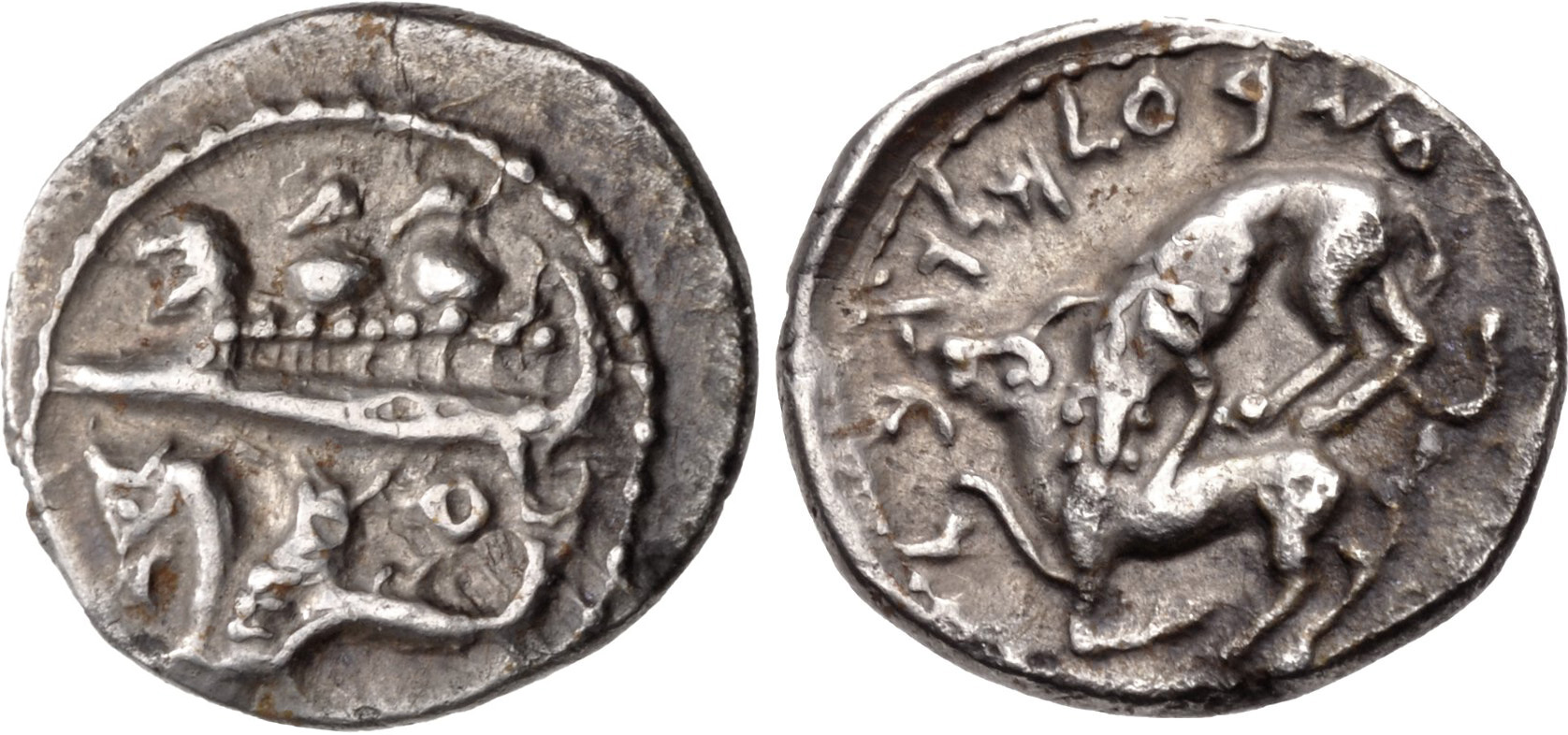S 1828 - Byblus (Ozba'al), silver, 16th shekels (400-370 BCE)
From SILVER
400 BCE - 370 BCE Silver 307 kg
Description
| ObverseInscription or printing placed on the obverse.: | (Phoenician).Two hoplites, holding shields, on galley left above waves, prow ending in lion's head, below, hippocamp left, 'Z (in Phoenician) above dorsal fin |
| ReverseInscription or printing placed on the reverse.: | ZB'L MLK GBL (Ozbaal, king of Gebal in Phoenician) above (Phoenician).Lion attacking bull left |
Mint and issuing power
| MintIdentifies the place of manufacture or issue of a numismatic object.: | Byblus | Ancient regionAncient region.: | Phoenicia | Modern countryModern country: Lebanon | AuthorityIdentifies the issuing power. The authority can be "pretended" when the name or the portrait of X is on the coin but he/she was not the issuing power. It can also be "uncertain" when there is no mention of X on the coin but he/she was the issuing power according to the historical sources: |
Chronology
| FromIdentifies the initial date in a range assigned in a numismatic context. | 400 BCE | toIdentifies the final date in a range assigned in a numismatic context.. | 370 BCE | PeriodTime period of the numismatic object.: Classical 480-323 BC |
Physical description
| MetalThe physical material (usually metal) from which an object is made.: | Silver |
Median weightMedian of the weights of numismatic objects (in grams). in grams | 0.75 | DenominationTerm indicating the value of a numismatic object. Examples: tetradrachm, chalkous, denarius.: | 16th shekel | StandardStandard.: |
Image

S1828 Byblus Oz'baal 16th shekels (400-370 BCE).jpg [1]
References
| Die study referencePublication of the study: | Elayi - Elayi 20141Elayi - Elayi 2014, p. 215-220, n° 727-771 | ||
| Coin series referenceReference to coin series study: | Sear II2Sear II, n° 6012, HGC 103HGC 10, n° 134 | ||
Obverse dies distribution
| FrequencyFrequency of specimen in distribution. ᵖ | Number of obversesNumber of obverse dies. ᵖ (o) | % (o) | Number of coinsNumber of coins. (n) | % (n) | Die nameName(s) of the die(s). |
| 1 | 4 | 26.67 | 4 | 10.26 | 4, 5, 12, 15 |
| 2 | 4 | 26.67 | 8 | 20.51 | 6, 9, 10, 14 |
| 3 | 4 | 26.67 | 12 | 30.77 | 1, 3, 8, 13 |
| 4 | 1 | 6.67 | 4 | 10.26 | 2 |
| 5 | 1 | 6.67 | 5 | 12.82 | 11 |
| 6 | 1 | 6.67 | 6 | 15.38 | 7 |
| Total | 15 of 15 | 100.02 | 39 of 39 | 100 |
Reverse dies distribution
no distribution is available
Quantification
| Number of obversesNumber of obverse dies. ᵖ (o) | 15 | Number of singletons (o1)The number of singleton coins. ᵖ | 4 |
| Number of reverse diesNumber of reverse dies. (r) | 20 | Number of coinsNumber of coins. (n) | 39 |
| Coins per obverse dieNumber of coins per obverse die. (n/o) | 2.6 | Coins per reverse dieNumber of coins per reverse die. (n/r) | 1.95 |
| Reverse per obverse ratioRatio of obverse dies divided by reverse dies. (r/o) | 1.33 | Percentage of singletons (o1)number of coins (n) divided by the number of singletons (o1) ᵖ | 26.67 % |
| Original number of dies (O) (Carter 1983 formula)The estimation of the number of coins according to Carter 1983 ᵖ | 20.46 | Coins struck if 20,000 as average productivity per dieCoins made if the average productivity for obverses (according to Carter) is 20,000. ᵖ | 409,200 |
| Original number of dies (O) (Esty 2011 formula)The estimation of the number of coins according to the singleton formula in Esty 2011 ᵖ (O) | 24.38 | Survival rate if 20,000 as average productivity per dieSurvival rate if average productivity is 20,000. ᵖ | 0.00010 |
| Coverage (o = % of O) (Esty 1984 formula)Esty 1984 - coverage (% of O) ᵖ (o = % of O) | 89.74% | Die productivity if survival rate 1/2,000Average productivity if survival rate is 1/2,000. ᵖ | 3,812.32 |
| Weight of silver (in kg) if 20,000 coins per die (O = Carter formula)Carter 1983 * Median weight * 20000 (*10 if gold or electrum) ᵖ | 307 kg <br /> 307 kg | Die productivity if survival rate 1/5,000Average productivity if survival rate is 1/5,000. ᵖ | 9,530.79 |
Remarks
Most likely one single workstation
References
- ^ Elayi, Josette - Elayi, Alain G. (2014), A Monetary and Political History of the Phoenician City of Byblos, Winona Lake, Eisenbrauns, xvi + 384 p.
- ^ Sear, David R. (1979), Greek coins and their values. Vol. II, Asia and North Africa, London, xlviii, p. 317-762
- ^ Hoover, Oliver D. (2010), The Handbook of Greek Coinage Series. 10. handbook of coins of the Southern Levant : Phoenicia, southern Koile Syria (including Judaea), and Arabia, Lancaster-London, lxxix, 201 p.